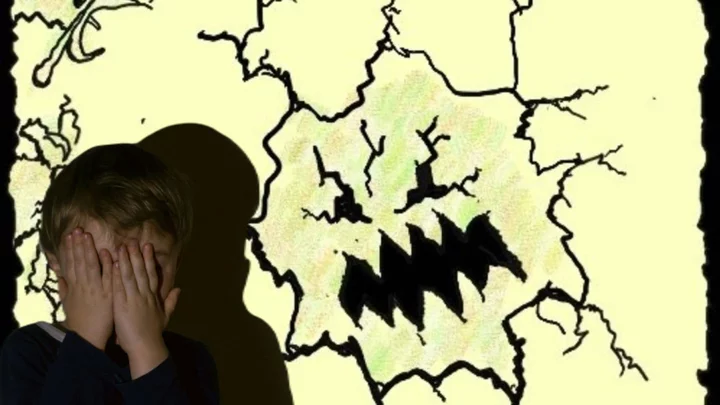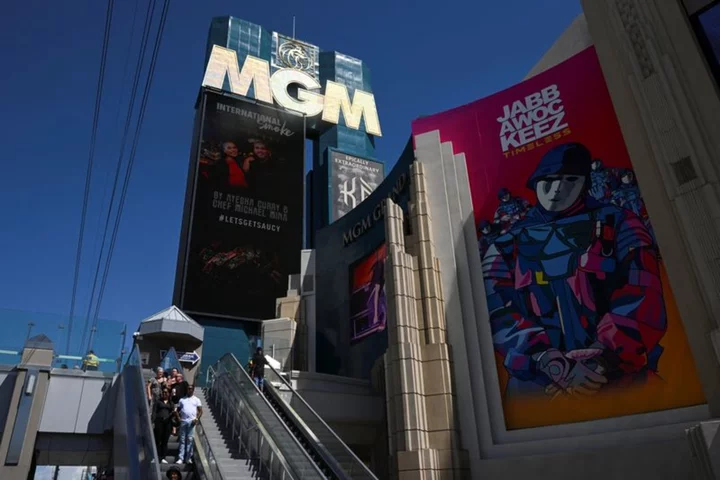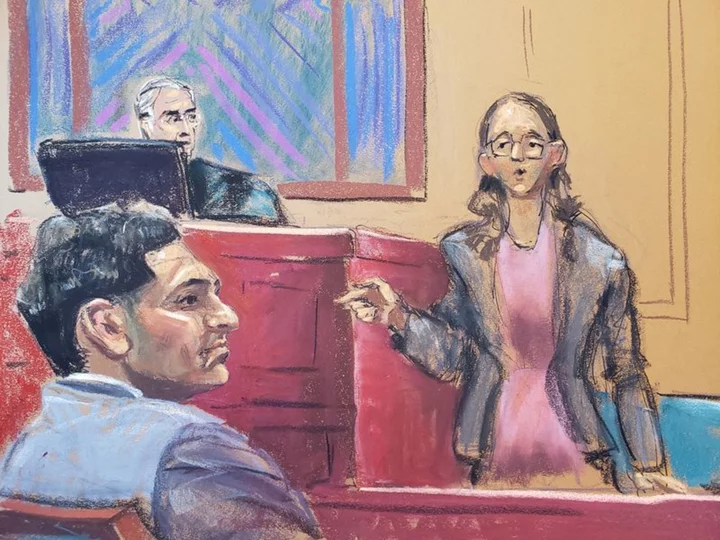Jon Armond was sitting in a radio station studio in rural Iowa when the fax came. It was unsigned and carried a message that sent his heart racing.
We have it.
For over 30 years, Armond had been searching for an animated segment on the PBS children’s program Sesame Street that he had first seen in 1975, when he was roughly 5 years old. He remembered plunking down on green shag carpeting and staring at a 25-inch console television at his home in Los Angeles, watching as a girl with a lilting voice was drawn out of her bed by friendly animals formed by cracks in her plaster wall; a jazzy score played in the background. The girl was having a good time—until another, far more malevolent shape appeared: A grimacing plaster monster who sneered until his sour demeanor forced him to crumble.
Like most Sesame Street cartoons, it lasted just minutes. But it carved out an impression on Armond that lasted a lifetime. The “crack monster,” as Armond called him, burrowed its way into his preadolescent brain, giving him nightmares.
Then Armond grew up, and the crack monster disappeared. No one he talked to seemed to remember the cartoon. Not even employees at Sesame Workshop, who told him they had no record of such a segment. Though Armond eventually found others who were familiar with the crack monster, it seemed like an example of the Mandela Effect, a shared (but false) memory.
“For years I thought I had just dreamt it,” Armond tells Mental Floss. “I’d ask someone and they had never heard of it.”
But here was an anonymous note, faxed to the station where Armond was a morning show host, that seemed to promise some kind of closure. All Armond had to do was agree to never distribute the segment online.
Armond had nothing to lose. He signed the document and faxed it back.
Nothing happened for six months. Then, one morning, he walked onto his front porch and noticed a manilla envelope sticking out of his mailbox. There was no return address and no postage. It was also a Sunday. No mail was ever delivered on Sundays.
Inside was a DVD labeled with a single word: Cracks.
Armond rushed inside and shoved the disc into his DVD player. Onscreen, Bert and Ernie were talking. Then he heard a familiar voice start to sing.
While layin’ in her bed … the cracks overhead …
Drawn to It
From its inception in 1969, Sesame Street took a multimedia approach to educational television. The brainchild of producer Joan Ganz Cooney and educator Lloyd Morrisett, the series used everything from Jim Henson’s Muppets to songs to friendly adults like Mr. Hooper to enrich an evidence-based curriculum. Everything about it, from Big Bird’s bright yellow feathers to Elmo’s childlike speaking cadence, was (and is) designed to draw children in.
From the outset, the show made use of animation. Filmation was an early contributor, rendering DC characters like Batman and Superman for the series. Independent animation houses were also recruited and asked to follow the show’s pre-planned themes and messages. Some could be abstract or even slightly surreal. And some, like “Cracks,” struck a chord.
“I think it was a lot of things,” Armond says of his aversion to the segment. “Most people will point to the end, with the crack monster on the wall. He’s a bad guy. But it’s really the whole thing before that. It was unsettling. The off-key music, like freeform jazz that doesn’t seem to be matching anything. The woman singing is singing in an eerie kind of way. And the fact that the girl is taken to another dimension.”
The latter, Armond says, hit him particularly hard thanks in part to another show. “My dad was a big Twilight Zone fan. There were marathons, too. So I watched a lot of The Twilight Zone—or watching my dad watch The Twilight Zone. I remember one episode where a girl was trapped in another dimension. She was calling out for her parents and they couldn’t find her. She was stuck in the walls. I remember that was super traumatizing to me.
“Then, in watching Sesame Street, it was the last place you’d expect to be scared. It reminded me of that, being in a room minding your own business and then being swept away.”
While some shorts aired frequently, this one was seen only intermittently at best. As internet sleuths would later discover, “Cracks” aired roughly a dozen times between its debut on December 31, 1975, and May 2, 1980. Each time was enough of a break for Armond to relax, forget about it, and then be galvanized all over again. “They would go months without airing it. Then I’d hear the first few notes … I was frozen,” he recalls. ”I didn’t look away. I endured it. I got freaked out and would have nightmares, then forget about it.”
The fact that “Cracks” ceased airing in 1980 meant that Armond began to perceive it as an increasingly unreliable memory—one maddeningly out of reach. He bought Sesame Street compilation tapes in the hopes it might be included. He struck up conversations with people about it, most of whom had no idea what he was talking about. There seemed to be little hope he would ever excavate “Cracks.”
Then, in the 2000s, Armond began frequenting message boards devoted to Sesame Street, television, and animation in the hopes someone might remember. They did. “With the advent of the internet, I put it out there and people were saying, ‘Yes, it traumatized me,’” he says. “So, OK, I didn’t dream it.”
People agreed with Armond. The “crack monster” had unsettled their nerves and had them crawling under their beds. But despite a growing library of obscure content on YouTube, the actual clip never surfaced. Armond tried reaching out to Sesame Workshop—then known as Children’s Television Workshop—to see if it could be located. There were only dead ends.
In posting about the short, Armond—who is an Emmy-nominated voiceover artist—typically signed off using his full name. “If you Googled my name, the first thing that came up is ‘morning person at radio station,’” he says. “The fax number was on the [station’s] website.”
In other words, he wasn’t hard to locate. Finally, after searching for the segment for years, Armond received the fax in 2008. He didn’t keep it and doesn’t remember its exact language, but recalls inferring that someone wanted him to stop probing. “Basically, the fax said, ‘Look, we have it.’ It didn’t use the term ‘cease and desist,’ but it gave the impression of, ‘We want you to shut up about this, we’ll send it to you if you agree to sign this waiver that you’re never going to post it.’”
Armond signed it. In 2009, the DVD materialized in his mailbox with another enigmatic message: We trust this completes your search. Because there was no postage on the envelope, it’s likely someone physically went to Armond’s house to drop it off.
After roughly 30 years, Armond watched as the girl is roused out of bed by animals made by cracks in her wall. A camel appears. “Today’s a rainy day,“ she says. “I can’t go out and play. Would you take me for a ride, camel?”
They’re soon joined by a monkey and a hen. But that’s not all of them. “At night behind the door, I think I’ve heard one more,” the monkey says. They encounter a large face in the wall that sneers before falling into pieces.
“Camel, thank you for the ride,” the girl says. “The rain has stopped outside. We’ll go and see the cracks again some day.”
At just over 1 minute and 40 seconds, the hypnotic segment was virtually just as he had remembered it. “The year before I got a copy, the people I was talking to who remembered it, we pieced it together. All the characters. It was in a storyboard kind of way. We got it pretty much right between us.”
There were some details his brain had misplaced. The snarling crack creature at the end was referred to as “crack master,” not “crack monster.” The bird was called a hen, not a chicken.
But Armond had a bigger problem. He couldn’t post it anywhere online.
The Crack Master
Armond was skeptical about whether or not the waiver he signed was legally binding, but he had no intention of finding out. He kept to his word and didn’t disseminate “Cracks” online, despite pleas from others who remembered it and wanted to see it again.
His first loophole was in making a recording for YouTube in which he reenacted the short using only audio with no video. “It’s a word-for-word version of me doing the clip,” he says. “It was a way to give people something, to prove I [did] have it.”
Then Armond found another workaround. The agreement he had signed stipulated that he not distribute the short—but it didn’t say anything about never showing it to anyone. While out in Los Angeles for his grandmother’s funeral, Armond contacted Jennifer Bourne, a cartoonist and fellow “Cracks” seeker who happened to live in the area. Bourne had posted about “Cracks” often, inviting comments on her blog but uncertain she would ever see it again after it made an impression on her at the age of 6.
“I wanted to believe him, but since I only knew him through the internet I was a little suspicious,” Bourne tells Mental Floss. “Shortly afterwards, he called me on the phone and played the cartoon.” Bourne was on a landline, so she could only hear the cartoon’s audio, but it was enough: “By then I was 95 percent sure he was playing the real clip, as opposed to something he'd just thrown together.”
The two agreed to meet at a coffee shop. Armond brought a portable DVD player, pressed play, and got to watch Bourne watch “Cracks.” (Bourne, however, recalls playing the DVD on her laptop.)
“I recognized it immediately,” Bourne says. “It was so weird finally seeing it again, especially after years of looking for it ... My only surprise was that ‘Crack Master’ was in fact rather scary-looking. Before I saw it again, I figured my then-kid brain had seen something more benign and exaggerated the creepy factor.”
For Armond, it was also a way to convince people online he had the real thing. “People still wanted me to post it, but I refused to do that,” he says. “But it was nice to have someone vouch for me.”
Armond kept his promise. Yet “Cracks” still wound up online in 2013, four years after Armond was surreptitiously slipped his copy. This time, a mysterious person contacted Daniel Wilson, webmaster of the Lost Media Wiki, a clearinghouse for obscure, missing, or otherwise hard-to-find media. Wilson received an email attachment from an anonymous address. Attached was “Cracks,” this time with no provisions on how it could be used. Wilson, naturally, shared it for the world to see.
What should have been a resolution proved perplexing. “Everyone was like, ‘Oh, Jon sent it to him,’” Armond says. “But our copies are different. My copy was from the airing of the show. It showed the last two seconds of a Bert and Ernie short, and then it went into the ‘Cracks’ segment. Then it showed the next thing at a zoo or something. Mine was pulled from an actual episode. The one he got had production notes. It clearly didn’t come from the same place or the same source, which only makes the story weirder.”
While “Cracks” was no longer an ephemeral memory, there was still the question of who had shared it with Armond and Wilson and why it was cloaked in such secrecy. In 2019, the Studio 360 podcast and producer Sam Kim took a closer look. They discovered that the reason Sesame Workshop hadn’t been able to locate “Cracks” for Armond was that he didn’t know the cartoon’s actual title until the DVD was dropped off; a search for “Crack Monster” hadn’t brought up anything. But looking for “Cracks” revealed it in their digitized archives. Virtually anyone at Sesame Workshop or their Long Island City archival area, where tapes are stored, could have brought it up, burned it to a DVD or attached it to an email, and sent it off—though Armond’s looked to be from a complete episode.
It’s not likely that person or persons will ever be revealed. But the Studio 360 podcast raised another mystery: Who created the crack master?
A Sketchy Background
No production credits exist on either copy of “Cracks.” Nor was Sesame Street in the habit of acknowledging animators during the closing episode credits circa 1975. In 2019, Sesame Workshop could tell Studio 360 only that a company named “P Imagination” was behind it, with music contributed by Mel Martin and the narration provided by Dorothy Moskowitz. The podcast located Moskowitz, who recalled the recording session in San Francisco but not who created the segment.
The name and location is a fit for Imagination, Inc., a Bay area animation company headed by Jeff Hale, his wife Margaret Hale, and partners John Magnuson and Walt Kraemer. Among their output were some shorts for Sesame Street, including the popular “Pinball Number Count” series. Mel Martin played saxophone in the segment.
Hale died in 2015, making his authorship hard to verify. When reached by Mental Floss, his daughter, Margot Hale, says that “Cracks” was probably the work of Imagination, Inc. but not necessarily her father’s. “It really does not look like my father’s work, especially the timing,” she says, referring to the mouth and body movements of the characters. “My father did direct many episodes and had ‘junior’ artists do the animation, so this might be the case here. Although the art direction does not look like his work, either.”
Another Bay area cartoonist, Sally Cruikshank, agrees that Hale may have supervised another artist’s work on the short. “It has a New York feel to me, [with] animation a bit under confident, like maybe giving someone a first chance at a job,” she tells Mental Floss. “I don’t think it was animated by Jeff Hale because his style was more sophisticated. But he could have offered it to some woman starting out—that would be my guess. He tried to get me work on Sesame Street around 1972 but nothing came of it.” (Cruikshank would later contribute to the show beginning in 1989.)
When contacted by Mental Floss, Fred Calvert and R.O. Blechman—both veteran animators who contributed shorts to Sesame Street in the 1970s—said they didn’t recognize “Cracks” and had no guesses as to who may have been responsible. Without a deep dive into Jeff Hale’s archives, its provenance may never be proven, though circumstantially, Imagination, Inc. is the leading contender.
If an animator were to be found, the children of the “Cracks” generation would surely have a question: Why was this segment so unnerving?
Child’s Play
Many adults can recall something on television or at the movies that unsettled them as a child. Some of it, like the fate of Bambi’s mother, isn’t hard to decipher. Others, like a random episode of Rugrats or a clown in The Brave Little Toaster, are more difficult to parse. Why does some kid’s content amuse one audience member and frighten another?
In the case of “Cracks,” it may have been a simple case of misdirection. “I can see how this cartoon could have traumatized many toddlers and developmentally young children,” Mona Delahooke, Ph.D., a clinical psychologist and author of Brain-Body Parenting tells Mental Floss. “It starts out with this lovely creative scene of exploration and safety with the cracks on the wall turning into a kind camel taking kids on an adventure and meeting new friends. This was setting the brain up for cues of safety, which is encoded as pleasurable.”
Then things take a dark turn. “The crack master appears as a monster, and the narrator’s voice changes. It violates the viewer’s prediction that something safe is going to happen by turning the crack in the wall into a threat. In other words, taking the prediction of safety and turning it into threat without warning. The brain doesn’t like that! It can be terrifying if you don’t have the ability to put it into context and make meaning of it symbolically.
“So, there’s a good reason that this little clip traumatized many toddlers. They didn’t have the developmental ability to tell themselves, ‘This is just a cartoon, monsters aren’t real,’ or otherwise make sense of it. It brought kids into this drama who may not have had the developmental architecture to see it as a simple cartoon.”
That sensory experience likely stayed with Armond and others because it was so visceral. “Young children’s brains remember sensory experiences—like visual or auditory, sights or sounds—that they encode as scary or threatening,” Delahooke says. “Those images can last a long time.”
For Bourne, the impression "Cracks" made wasn’t hard to figure out. “When he fell apart it was like the kid-friendly version of the melting faces in Raiders of the Lost Ark,” she says. “I was old enough to understand that cracks couldn’t come to life, but the idea that there could be a cracked wall that looked like a monster was creepy too.”
Those experiences can be generational and heavily dependent on cultural context. When Armond found “Cracks,” his own children were between 8 and 12 years old. He showed it to them not quite sure how they’d respond. “I showed them and they said, ‘I don’t get it. What’s the big deal? There’s nothing scary about it.’ Anyone who grew up in the era of YouTube or streaming would not think the same way. It only affected kids who were not really exposed to anything. No kid today would find it disturbing or scary. They’ve seen much worse. But a kid in the 1970s who wasn’t exposed to anything, it’s different.”
Something different clearly happened with “Cracks.” Rather than running it in perpetuity, it vanished in 1980. With his curiosity over its existence satisfied, Armond turned to pondering why it was seemingly abandoned. An official answer probably isn’t forthcoming: A spokesperson for Sesame Workshop referred Mental Floss to the Studio 360 podcast and said there wasn’t much more they could add.
“It just disappeared to where no one could find it,” Armond says. “I honestly don’t know why. But it was clearly intentional.”
One possible answer may be found right in the title.
Repairing the Crack
Two things happened in the first week of May 1980. Sesame Street aired “Cracks” for the last time, and Rolling Stone published a shattering report on the growing crack cocaine epidemic.
The word crack quickly became shorthand for the cheap, smokable cocaine that decimated urban communities, particularly in New York. It dominated headlines in the 1980s and became a political maelstrom. Suddenly, a cartoon about a “crack master” in a home with crumbling plaster walls took on a new and unintended meaning.
Sesame Workshop was acutely attuned to criticism. Parents could—and often did—write in to register complaints about content they found objectionable. When Margaret Hamilton reprised her role as the Wicked Witch from The Wizard of Oz (1939) on the program in 1976, adults complained that it was too upsetting for kids. (In a situation not dissimilar to “Cracks,” an anonymous source later uploaded the segment in 2022. The “leak” prompted a stern rebuke from the American Archive of Public Broadcasting, where the entire series is archived and where it’s possible the footage was obtained. Or, in the words of the AAPB, “improperly downloaded.”)
While it’s possible letters expressing concern over “Cracks” are somewhere in the Children’s Television Workshop archives held at the University of Maryland, it’s not likely that producers needed any coaching. In the wake of the crack epidemic, “Cracks” and its language could easily be perceived as tone-deaf. Ben Lehmann, who was the executive producer of Sesame Street through 2022, told the Studio 360 podcast in 2019 that the short “felt dated” and “probably producers at the time thought it was inappropriate.”
But “Cracks” stopped airing in 1980, several years before the crack epidemic began appearing regularly in headlines. (In 1986, The New York Times called it a “so new a phenomenon that police have no accurate statistics” on its use.) Would Sesame Street really have pulled it over a single Rolling Stone article?
Another possibility: “Cracks” had a slightly confusing message. While the “crack master” is chastised for being too mean, it all happens so quickly that the viewer is left slightly befuddled.
“The theory that makes the most sense to me is that Sesame Street didn’t necessarily feel the message it was trying to get through was getting through,” Armond says. “Even if you ask people what it was about, what the lesson was, you get different stories. It’s not necessarily teaching the lessons they wanted it to teach. I don’t think the message was clear enough for them to keep it over the other shorts.”
“Cracks” enthusiasts may never know for certain why it disappeared or who conjured up the dreamlike and subjectively unsettling scenario. But that, Armond says, is probably missing the point: “I think the person who made it had good intentions. It was for a kids’ show, for kids living in poverty. Their living conditions might not be the best. The message was, be nice to people. Don’t be mean like crack master.”
That some weirdness continues to spiral around “Cracks” is probably fitting. It is, after all, a Sesame Street segment lasting less than two minutes that was once dropped off by a stranger at Armond’s doorstep. The how and why of it all isn’t as interesting to Armond as the end result. After more than 30 years of wondering if he would ever hear that distinctive music and see the plaster creature once more, he finally did—and he was 5 years old again.
Related Tags
CULTURE TELEVISION ANIMATION Pop Culture ENTERTAINMENT NEWS ANIMALS WEIRD TV BUSINESS Home / ENTERTAINMENT








